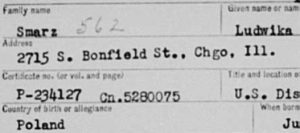Does anyone have any idea why the naturalization numbers and names mentioned in an index wouldn’t match with the names and numbers on the naturalization petition images? Are there different numbering systems?
I started with the tip sheet (1) that Rosanna Hogarty posted to the Chicago Genealogy page on Facebook. The tip sheet was clear and organized well. And, I was excited to jump right into the search.
But, I was puzzled that for two out of three of my Polish great grandparents that I found in the index, the numbers listed on the index card led me to a petition for a different person.
Match
First, the one that matched. Louisa Smasz’ record in the index (2) did match the record the petition (3). It was also easy to find using the tips provided by Hogarty.

Louisa Smasz in index (record P. 234127) (2)

Louisa Smasz petition (record P.234127) (3)
First Mismatch
While I found an index record for Louisa Smasz’ husband, Piotr, the name on the petition did not match. Piotr’s index card (4) listed number P.56992, but the application with number P. 56992 (5) belonged to someone named John Silinskas. The doubly strange part of this is that I have a copy of Piotr Smasz’ petition number P. 56992 (6) that was included in a packet from the U.S. Citizenship and Immigration Services FOIA request response. The “best reproducible copy” may not be the best, but the petition number and name are readable in the paper copy and match Peter Smasz’ index card. Unfortunately, I couldn’t produce a readable image to share in the blog.

Piotr Smasz in index (record P. 56992) (4)

John Silinskas petition (record P.56992) (5)
Second Mismatch
Similarly, Vincent Szubinski’s index card (7) listed number P.69199, but the application with number P.69199 (8) belonged to a person named Erik Hugo Peterson. I also have a copy of Vincent Szubinski’s petition from the USCIS Genealogy Program (9) that does match his index card and is clear enough to share here.

Vincent Szubinki in index (record P.69199) (7)

Erik Hugo Peterson’s petition (record P.69199) (8)

Vincent Szubinski Naturalization Petition from USCIS Genealogy Program (9)
I did try browsing the petition images by the petition date instead of petition number, but didn’t find Piotr’s or Vincent’s peitions in the online images.
Notes
I noticed when comparing the FamilySearch images to the USCIS copies that the image of the naturalization petitions available through FamilySearch are original copies while the copies of naturalization petitions available from the USCIS Genealogy Program are duplicate copies.
I am thankful that the FOIA request yielded the response that I received. One explanation is one the USCIS Genealogy Program website (10):
The USCIS Genealogy Program uses indices unlike any immigration or naturalization index available to the public. Our unique Master Index system is a combination of index tools—partially automated and partially manual—that work together to identify and locate old agency files and records.
I’m am very curious why a person would be indexed in “Illinois, Northern District Naturalization Index, 1840-1950,” when their petition doesn’t appear in “Illinois, Northern District Petitions for Naturalization, 1906-1994.”
I would love to hear from anyone who knows why this discrepancy is happening or from anyone experiencing similar challenges.
The lesson is to not give up, even if you don’t find the records where you think you should.
References
(1) Rosanna Hogarty; Chicago Genealogy group on Facebook; uploaded file; 20 Oct 2015: https://www.facebook.com/groups/45933825528/: accessed 24 Mar 2016; “How to use the Illinois District Court Records Naturalization files on www.familysearch.org” file
(2) “Illinois, Northern District Naturalization Index, 1840-1950,” database with images, FamilySearch (https://familysearch.org/ark:/61903/1:1:XKPS-4HT : accessed 7 April 2016), Ludwika Smarz, 1941; citing Chicago, Illinois, NARA microfilm publication M1285 (Washington D.C.: National Archives and Records Administration, n.d.), roll 164; FHL microfilm 1,432,164.
(3) “Illinois, Northern District Petitions for Naturalization, 1906-1994,” images, FamilySearch (https://familysearch.org/pal:/MM9.3.1/TH-1942-44405-52448-81?cc=2212212 : accessed 25 April 2016), Cook County > Petitions, 1941, v. 965, no. 233901-234250 > image 708 of 1079, Ludwika Smarz, P.234127; citing NARA NAID 593882, National Archives at Chicago, Illinois.
(4) “Illinois, Northern District Naturalization Index, 1840-1950,” database with images,FamilySearch (https://familysearch.org/ark:/61903/1:1:XKPS-4ZK : accessed 7 April 2016), Piotr Smarz, 1924; citing Illinois, NARA microfilm publication M1285 (Washington D.C.: National Archives and Records Administration, n.d.), roll 164; FHL microfilm 1,432,164.
(5) “Illinois, Northern District Petitions for Naturalization, 1906-1994,” images, FamilySearch (https://familysearch.org/pal:/MM9.3.1/TH-909-55385-1161-59?cc=2212212 : accessed 25 April 2016), Cook County > Petitions, 1928, v. 326, no. 56801-57050 > image 708 of 926, John Silinskas, P.56992; citing NARA NAID 593882, National Archives at Chicago, Illinois.
(6) U.S. Department of Homeland Security. C-File. U.S. Citizenship and Immigration Services, Washington, D.C., C-1784133, Piotr Smarz, age 35, Superior Court, Chicago, IL, 7 March 1924, FOIA request fulfilled 15 Feb 2015
(7) “Illinois, Northern District Naturalization Index, 1840-1950,” database with images,FamilySearch (https://familysearch.org/ark:/61903/1:1:XKGY-HP2 : accessed 7 April 2016), Wincenty Szubinski, 1926; citing Illinois, NARA microfilm publication M1285 (Washington D.C.: National Archives and Records Administration, n.d.), roll 151; FHL microfilm 1,432,151.
(8) “Illinois, Northern District Petitions for Naturalization, 1906-1994,” images, FamilySearch (https://familysearch.org/pal:/MM9.3.1/TH-909-55876-27502-14?cc=2212212 : accessed 25 April 2016), Cook County > Petitions, 1929, v. 375 no. 69051-69300 > image 575 of 963, Erik Hugo Peterson, P.69199; citing NARA NAID 593882, National Archives at Chicago, Illinois.
(9) U.S. Department of Homeland Security. C-File. U.S. Citizenship and Immigration Services, Washington, D.C., C-2337865, Wincenty Szinbinski, b 15 Jul 1884, Superior Court, Chicago, IL, 30 Apr 1926, FOIA request fulfilled 30 Nov 2010
(10) U.S. Citizenship and Immigration Services; “USCIS Genealogy Program – Searching the Index” https://www.uscis.gov/history-and-genealogy/genealogy/searching-index: accessed 25 April 2016









